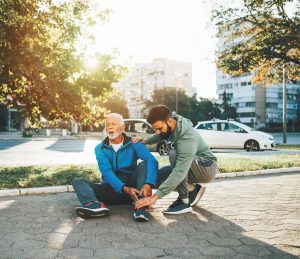By Joe Altepeter, DPM


From the foot and ankle perspective there are a number of things that can be considered to improve balance and decrease the chances of falls. First and foremost being the use of appropriate shoe gear. With “appropriate” being an important descriptor for the length, width, comfort, and stability of the shoes. Over the course of one’s lifetime there are plenty of musculoskeletal changes that can take place and make last decade’s sneakers obsolete. Routinely being fitted for shoes is important, and ensuring appropriate fit will help decrease soreness related to pressure points that may incite gait abnormalities. This is best done towards the end of the day after performing regular daily activities to accommodate for any swelling that may take place. For someone with baseline poor balance, stability of a shoe is key. The back of the shoe around the heel, or the heel counter, should be relatively stiff. The sole of the shoe should also be relatively stiff with enough bend along the toe box for adequate range of motion for propulsion. The middle of the shoe, or the shank, should withstand twisting and bending as well.
For those with more significant musculoskeletal issues additional stabilization may be necessary. There are a number of different types of orthoses and bracing options that could be considered to help correct biomechanical disturbances that may alter gait. Deformities and altered mechanics that primarily occur at the level of the foot may be well suited with some motion controlling over the counter or custom orthotics, while bracing options that include the foot and lower leg, and even the knee, may be necessary for more significant musculoskeletal pathology. These are options that your podiatrist could make recommendations.
Evaluation and management by the physical therapy department is also a mainstay for preserving strength and confidence with ambulation. They can help put together a game plan to tackle any musculoskeletal pathology, nerve related symptoms, or balance concerns from a therapy perspective. This would likely involve pointed muscular stretching and strengthening exercises, gait reinforcement and assistance with mobilization, balance and proprioceptive exercises, among others. Part of the rehabilitative process may involve use of an assistive device. Short or long term use of a cane, walker, scooter, or wheelchair may be necessary to assist with balance and avoid falls.
Check in with your local podiatrist for advice on the options mentioned above and to put together a game plan for keeping you on your feet.
Joe Altepeter, DPM, AACFAS, is a Podiatrist at Family Foot & Leg Centers in Fort Myers FL. He is a Fellow of the American College of Foot & Ankle Surgeons. Call 239-430-3668 or visit www.NaplesPodiatrist.com to make an appointment. Visit FootHealthFacts.org to learn more about foot and ankle conditions.
1645 Colonial Blvd.
Fort Myers, FL 33907
(239) 430 – 3668 (FOOT)
www.NaplesPodiatrist.com
Disclaimer: This content is not intended to be a substitute for professional medical advice, diagnosis, or treatment. Always seek the advice of your physician or other qualified health care provider with any questions you may have regarding a medical condition.
 Southwest Florida's Health and Wellness Magazine Health and Wellness Articles
Southwest Florida's Health and Wellness Magazine Health and Wellness Articles

